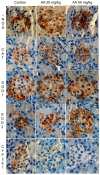Acrylamide and Potential Risk of Diabetes Mellitus: Effects on Human Population, Glucose Metabolism and Beta-Cell Toxicity
- PMID: 35682790
- PMCID: PMC9181725
- DOI: 10.3390/ijms23116112
Acrylamide and Potential Risk of Diabetes Mellitus: Effects on Human Population, Glucose Metabolism and Beta-Cell Toxicity
Abstract
Diabetes mellitus is a frequent endocrine disorder characterized by hyperglycemia. Acrylamide (AA) is food contaminant formed during the high-temperature processing of food rich in carbohydrates and low in proteins. Recent human epidemiological studies have shown a potential association between AA exposure and the prevalence of diabetes in the general population. In male rats, AA treatment promoted pancreatic islet remodeling, which was determined by alpha-cell expansion and beta-cell reduction, while in female rats AA caused hyperglycemia and histopathological changes in pancreatic islets. In vitro and in vivo rodent model systems have revealed that AA induces oxidative stress in beta cells and that AA impairs glucose metabolism and the insulin signaling pathway. Animal studies have shown that diabetic rodents are more sensitive to acrylamide and that AA aggravates the diabetic state. In this review, we provide an overview of human epidemiological studies that examined the relation between AA exposure and glucose disorders. In addition, the effects of AA treatment on pancreatic islet structure, beta-cell function and glucose metabolism in animal models are comprehensively analyzed with an emphasis on sex-related responses. Furthermore, oxidative stress as a putative mechanism of AA-induced toxicity in beta cells is explored. Finally, we discuss the effects of AA on diabetics in a rodent model system.
Keywords: acrylamide; beta-cell toxicity; diabetes mellitus; glucose metabolism; human epidemiological studies; in vitro; in vivo; oxidative stress.
Conflict of interest statement
The authors declare no conflict of interest.
Figures





Similar articles
-
Subchronic exposure to acrylamide leads to pancreatic islet remodeling determined by alpha cell expansion and beta cell mass reduction in adult rats.Acta Histochem. 2018 Apr;120(3):228-235. doi: 10.1016/j.acthis.2018.02.002. Epub 2018 Feb 15. Acta Histochem. 2018. PMID: 29454490
-
Effects of subchronic acrylamide treatment on the endocrine pancreas of juvenile male Wistar rats.Biotech Histochem. 2018;93(2):89-98. doi: 10.1080/10520295.2017.1393562. Epub 2018 Jan 10. Biotech Histochem. 2018. PMID: 29319366
-
Glucose and ATP levels in pancreatic islet tissue of normal and diabetic rats.J Clin Invest. 1976 Nov;58(5):1193-200. doi: 10.1172/JCI108572. J Clin Invest. 1976. PMID: 136453 Free PMC article.
-
Diabetic hyperglycemia: link to impaired glucose transport in pancreatic beta cells.Science. 1991 Mar 8;251(4998):1200-5. doi: 10.1126/science.2006409. Science. 1991. PMID: 2006409 Review.
-
Modulation of the pancreatic islet-stress axis as a novel potential therapeutic target in diabetes mellitus.Vitam Horm. 2014;95:195-222. doi: 10.1016/B978-0-12-800174-5.00008-9. Vitam Horm. 2014. PMID: 24559919 Review.
Cited by
-
Protective Effects of Wine Polyphenols on Oxidative Stress and Hepatotoxicity Induced by Acrylamide in Rats.Antioxidants (Basel). 2022 Jul 10;11(7):1347. doi: 10.3390/antiox11071347. Antioxidants (Basel). 2022. PMID: 35883838 Free PMC article.
-
Chemical Compounds and Ambient Factors Affecting Pancreatic Alpha-Cells Mass and Function: What Evidence?Int J Environ Res Public Health. 2022 Dec 8;19(24):16489. doi: 10.3390/ijerph192416489. Int J Environ Res Public Health. 2022. PMID: 36554367 Free PMC article. Review.
-
Reduction of eEF2 kinase alleviates the learning and memory impairment caused by acrylamide.Cell Biosci. 2024 Aug 23;14(1):106. doi: 10.1186/s13578-024-01285-7. Cell Biosci. 2024. PMID: 39180059 Free PMC article.
-
Food contaminants and potential risk of diabetes development: A narrative review.World J Diabetes. 2023 Jun 15;14(6):705-723. doi: 10.4239/wjd.v14.i6.705. World J Diabetes. 2023. PMID: 37383596 Free PMC article. Review.
-
The association between dietary acrylamide intake and the risk of type 2 diabetes incidence in the Tehran lipid and glucose study.Sci Rep. 2023 May 22;13(1):8235. doi: 10.1038/s41598-023-35493-x. Sci Rep. 2023. PMID: 37217800 Free PMC article.
References
-
- Wang B., Qiu W., Yang S., Cao L., Zhu C., Ma J., Li W., Zhang Z., Xu T., Wang X., et al. Acrylamide Exposure and Oxidative DNA Damage, Lipid Peroxidation, and Fasting Plasma Glucose Alteration: Association and Mediation Analyses in Chinese Urban Adults. Diabetes Care. 2020;43:1479–1486. doi: 10.2337/dc19-2603. - DOI - PubMed
-
- Xiong B., Loss R.D., Shields D., Pawlik T., Hochreiter R., Zydney A.L., Kumar M. Polyacrylamide degradation and its implications in environmental systems. NPJ Clean Water. 2018;1:17. doi: 10.1038/s41545-018-0016-8. - DOI
-
- Ghamdi A., Alenezi F., Algoferi M., Alhawas M., Farga A., Afifi M. A Review on the New Trends of Acrylamide Toxicity. Biomed. J. Sci. Tech. Res. 2020;27:20638–20644.
-
- Adani G., Filippini T., Wise L.A., Halldorsson T.I., Blaha L., Vinceti M. Dietary Intake of Acrylamide and Risk of Breast, Endometrial, and Ovarian Cancers: A Systematic Review and Dose-Response Meta-analysis. Cancer Epidemiol. Biomark. Prev. 2020;29:1095–1106. doi: 10.1158/1055-9965.EPI-19-1628. - DOI - PubMed
Publication types
MeSH terms
Substances
Grants and funding
LinkOut - more resources
Full Text Sources
Medical

